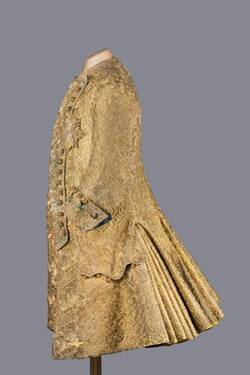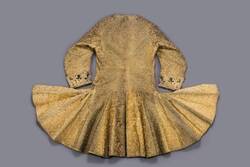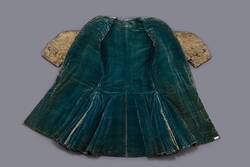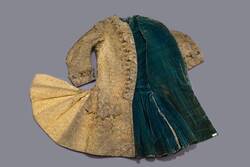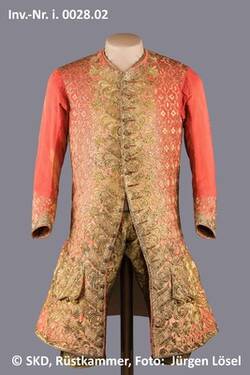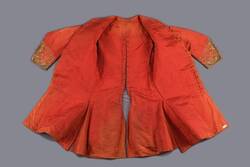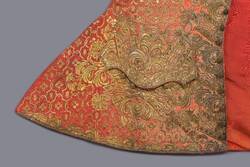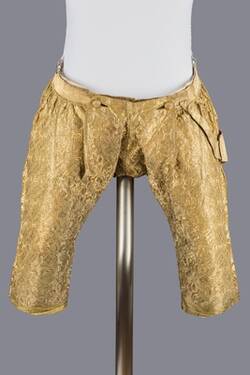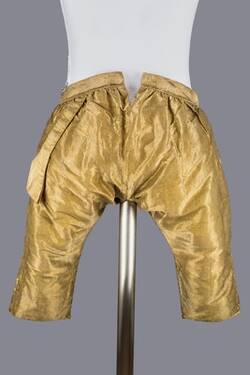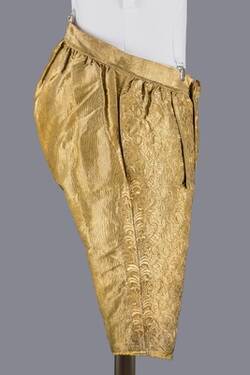This golden state dress, with the star of the Royal Polish Order of the White Eagle on its breast, occupies a very special place in the Royal Wardrobe. The resplendent effect of the coat and breeches made of cloth-of-gold and the poppy-red waistcoat is further enhanced by the embroidery in gold thread. The king was wearing this magnificent dress when he appeared on horseback at the jousting tournament held in the Stallhof – the stable yard – during the electoral prince’s wedding in 1719.
The lavish gold embroidery combines a mesh of quatrefoil loops with blossoms covering the body of the coat with a border of sweeping groups of leaves, palmettes and carnations. The motifs, which were embroidered over parchment underlay, give the dress a rich, three-dimensional texture. This embroidery technique used a lot of material, since all the motifs are repeated on the back. As a result – and due to the vast amount of cloth required – the costume weighs almost seven kilogrammes, more than fifteen pounds. The hem circumference of the coat is a generous 526 centimetres– that’s over 17 feet. Today, 96 decorative passamenterie buttons adorn the costume. One has been lost, because there were originally 97.
The gold dress was so precious that the king decided to wear it a second time, eleven years later, this time as military state dress. The occasion was the opening parade at the Zeithain Encampment – a grand military review showcasing the Saxon army in the presence of the King of Prussia and his son.
August the Strong had the coat altered for the occasion, selecting a blue velvet fabric: embroidered lapels were added, the cuffs reduced, and the coat was extensively lined. The corners of the laps, front and back, could be turned outwards and secured with hooks at the side. This displayed the blue of the Chevalier Garde to better effect – a unit captained by the king himself.
So we have evidence that August the Strong wore a golden state dress three times: for his coronation in Cracow in 1697, at his son’s wedding in 1719, and at the Zeithain Encampment in 1730. Even Louis the Fourteenth, his role model in matters of kingship and fashion, only appeared at a very few events dressed in gold.
Further Media
- Location & Dating
- Outer fabric: French. Tailoring: Dresden. 1719. Revised 1730.
- Material & Technique
- Coat: outer fabric: lampas-like gold fabric ("glacé drap d´or"), gold embroidery; lapel: lapel and lining of the coat in blue silk velvet; star appliquéd: relief embroidery primarily in satin stitch of gold weave, gold purl, silver weave; waistcoat: Cannelé ("Gros de Tours") ponceau (salmon red), gold embroidery; lining fabric: taffeta, ponceau, intermediate layer: linen, light natural colours, skirt padding in silk lining; buttons: wood, gold wire, gold weave (56 on the skirt, 37 on the waistcoat, 3 on the trousers); lace fastening on the back of the waistcoat.
- Dimenions
- Taillenumfang 108 cm Saumumfang 551 cm Rückenbreite 36,6 cm Vorderbreite 47 cm Schulterbreite 15,7 cm VM Vorderlänge gesamt (ohne Kragen) 102,5 cm Vorderlänge (Schulter-Saum) 114 cm HM Rückenlänge (ohne Kragen) 103 cm HM Schlitzlänge 46,1 cm Faltenlänge/ Schlitzlänge Rücken re/li 43,5 cm Eingriff Rücken re/li 38 cm HM Rückenlänge gesamt (ohne Kragen) 103 cm Armlochumfang (Vorder-/Rückenteil) 55,6 cm Halsumfang Kragen 46 cm Außenweite Kragen 38 cm VM Kragenhöhe 0 cm HM Kragenhöhe 1 cm Ärmelsaum Umfang 32,6 cm Ärmellänge gesamt 55 cm Ärmelschlitzlänge 17 cm Ärmelaufschlagumfang 39,5 cm Ärmelaufschlagbreite 10,5 cm Tascheneingrifflänge 21,3 cm Taschenpattenlänge 27,5 cm Taschenpattenbreite 16 cm Gewicht 4,561 kg Gesamtgewicht mit Figurine 21,840
- Museum
- Rüstkammer
- Inventory number
- i. 0028.01
